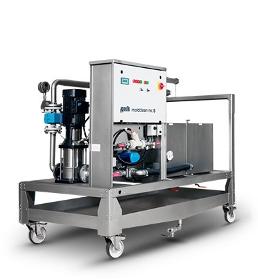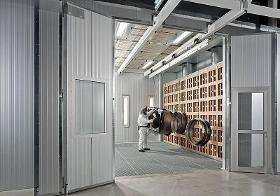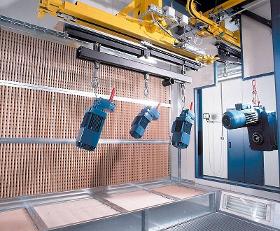- europages
- >
- COMPANIES - SUPPLIERS - SERVICE PROVIDERS
- >
- individual cases
Results for
Individual cases - Import export

BEKO TECHNOLOGIES GMBH
Germany
In addition to filtration, compressed-air drying contributes significantly to an increase in process reliability. Humidity in compressed-air systems causes corrosion, and promotes the growth of micro-organisms. In individual cases, condensate emerges at the point of use - an ongoing danger for the operational flow, for example because of failing pneumatic controls, increased wear and tear or because of other disturbances in the production process. With considerably enhanced process reliability, the DRYPOINT dryer technology offers decisive advantages for every field of application. The BEKO TECHNOLOGIES portfolio comprises application-optimised refrigeration, adsorption and membrane dryers for volumes up to 1,500 m³/h. This range of dryers is completed by heat-regenerated EVERDRY adsorption dryers which are designed for large volume flows up to 20,000 m³/h.
Request for a quote
TINY TECHNOLOGIES GMBH
Germany
TINY offers the TINY Research Cooperation, where, based on TINYsphere® technologies, we collaboratively develop highly effective dietary supplements, cosmetics, and pharmaceutical products with our clients. These initiatives go beyond the TINY White Label and TINY Private Label ranges, opening up new avenues in product development. Our scientists analyze complex challenges and devise tailored solutions for individual business cases. Furthermore, we assist clients in creating innovative market novelties. Within the scope of contract research, our research and development department creates innovative products with exceptional bioavailability, stability, and shelf life. We utilize naturally pure raw materials from reliable, certified sources and provide comprehensive guidance and support throughout the entire manufacturing process, from conception to delivery. We look forward to your call: Phone: +49 (0) 40 87409824
Request for a quote
OPTIMEL SCHMELZGUSSTECHNIK GMBH
Germany
Optimel is your reliable partner for solutions for encapsulating electrical and electronic assemblies. The innovative Low Pressure Moulding (LPM) technology offers optimal protection against external influences such as moisture, dust and vibrations, thus ensuring the longevity and reliability of your products. The Low Pressure Moulding process or hotmelt moulding process originated in the sealing of cable harnesses in the automotive industry - today it is used in many areas for the protection of electrical and electronic components. At 5-40 bar (in individual cases up to max. 60 bar), processing takes place at a much lower pressure than in the classic hotmelt injection moulding process. This makes it easy to directly encapsulate even sensitive components such as circuit boards, sensors, etc. The cycle times are limited to pure encapsulation
Request for a quote
TECHNOTRANS SOLUTIONS GMBH
Germany
Lime and corrosion are hidden cost factors. Inevitably, these two “enemies of temperature control channels” prolong the cooling time, reduce the process safety and have a negative influence on the parts’ quality. The problem occurs insidiously in each plastic processing company, because lime and corrosion gradually build an insulation layer in the cooling channels and are thus responsible for a deteriorating heat transfer. Often the problem is not recognized until the demanded parts’ quality cannot be achieved any longer or if the complete system breaks down. The effect of cleaning the cooling channels of an injection mould is a reduction of cooling time up to 40 % (in individual cases even more), depending on the amount of deposits. The latest development, easy to use by the processor himself, is moldclean, a compact appliance which cleans polluted cooling channels in injection moulds and heat exchanger systems.
Request for a quote
RIPPERT ANLAGENTECHNIK GMBH & CO. KG
Germany
Immersible objects can be painted economically with the aid of dip painting. Rapid and complete wetting takes place by the immersion of the workpieces. By comparison, electrophoretic coating is more complex, but it is more advantageous in individual cases. ADP / CDP electrophoretic dip coating Electrophoretic dip coating is a modern, efficient painting method and is used extensively in industry for the coating of metals and metallised plastic surfaces. In the electrolytic coating of components using direct current, distinction is made between cathodic dip painting (CDP) and anodic dip painting (ADP), depending on the polarity. The paint film is deposited onto the object surface from an aqueous paint dispersion by the effect of a DC current. In anodic dip painting (ADP) the article being painted is connected as the anode, while in cathodic dip painting (CDP) it forms the cathode. When current flows, the paint dispersion, which contains the ionically stabilised paint particles, coagulates in the acidic boundary layer (ADP) or alkaline boundary layer (CDP) and forms a paint film, which adheres well and is hard and resistant to corrosion after hardening. Advantages:
Request for a quoteDo you sell or make similar products?
Sign up to europages and have your products listed

RIPPERT ANLAGENTECHNIK GMBH & CO. KG
Germany
With high-quality filter tubes and PTFE diaphragms. Paint dust filters Wet painting also results in overspray. Overspray is the solid portion of the paint that is not taken up by the workpiece. According to the purpose of use, the overspray is moist and sticky immediately after release. It is captured by the exhaust air stream in the spray booth and fed to a filter. This can be, for example, a baffle plate filter, paper filter, fleece filter, glass fibre filter or also combinations of these. The adhesive effect causes the paint particles to adhere to the contact surfaces of the respective filter medium, as a result of which a good degree of separation is achieved. However, all these filters are storage filters, i.e. the filters clog up more and more during operation and cannot be regenerated. A filter exchange becomes necessary if the exhaust air rate of the spray booth falls below the minimum. This can be very time-consuming under certain circumstances and the work process must be interrupted in order to do it. To make things worse, not only must the filtered and bound paint residues be disposed of, but also the actual filter materials. Such tooling times are not justifiable for automatic, continuous or multi-layer painting processes. Continuous procedures such as automatically cleaned filters are likewise required for this. The humidity and the adhesiveness of the particles to be filtered are thereby the problem. In order to solve this problem, the paint particles should be relieved of their adhesive capability as far as possible whilst still inside the paint booth. Our patented ‘RTS-Rotation’ system is outstandingly well suited for this. The system is comprised of slowly rotating brush rollers, which take up the adhesive paint particles on the surface of the bristles and allow them to dry there. The bristles are automatically regenerated at pre-specified time intervals by combing devices that swing in at the rear of the brush rollers. The dislodged paint residues can then be removed and disposed of either manually during work breaks or automatically during operation. The degree of separation of this system is, however, insufficient to satisfy the environmental protection requirements concerning residual dust content in the exhaust air. A further filter stage is necessary for that. It must be assumed that the paint particles arriving here are to a certain extent still damp and sticky. For this we use special paint dust filters with high-quality filter tubes with PTFE diaphragms. If necessary, precoating agents (auxiliary dust) are used in order to neutralise the adhesive capability of the particles and to keep the dust layer on the filter elements permeable to air. The precoating agent is injected into the raw air pipe by means of special dosing units. The filter tubes are cleaned by means of compressed air impulse cleaning. The use of this technology requires special know-how. We have had the appropriate experience for almost ten years. The implemented plants have capacities ranging from 5,000 to 90,000 m³ /h. Because of the large number of different paint systems, individual experiments are usually necessary in our pilot plant in order to find the correct solution for the individual case.
Request for a quote
RIPPERT ANLAGENTECHNIK GMBH & CO. KG
Germany
Spray walls and spray booths with dry separation via cartons. For lower utilisation times or overspray quantities RES dry spray booth For lower utilisation times or smaller overspray quantities, spray systems with dry separation offer a meaningful alternative to water-sprinkled systems. The Rippert modular spraying system type RES enables individual adaptation to the respective case of need. The filter system of the RES dry spray wall consists of individual square cardboard boxes. A sheet metal frame serves as a support structure for the filter box. In order to save costs, there is a possibility to vary the individual filter boxes in the spray booth, without exchanging all of the filter elements. Function The overspray is caught by the exhaust air stream and fed to the filter. The solids are filtered out here, while the cleaned exhaust air is blown out into the open air by the fan. Versions The basic version consists of a wall with a two-fold filter stage. Paper filter boxes form the first filter stage. A glass fibre fine filter arranged directly behind it represents the second filter stage. The attached radial fan is equipped with spark protection in the suction nozzle as well as an explosion-proof motor. The spray booth can additionally be equipped with removable or fixed side and ceiling panels. The RES dry spray booth is available in galvanised sheet metal or in stainless steel. Advantages Cleaning / maintenance The spray wall is designed such that the filter elements can be exchanged with little effort in a very short time. Once it is saturated, the filter box is removed from the sheet metal frame and disposed of in an environmentally-friendly manner.
Request for a quote
RIPPERT ANLAGENTECHNIK GMBH & CO. KG
Germany
Spray walls and spray booths with dry separation via pre-filters and fine filters. Spray walls and spray booths with dry separation For lower utilisation times or overspray quantities, spraying systems with dry separation offer a meaningful alternative to water-sprinkled systems. The Rippert modular spraying system type RTS enables individual adaptation to the respective case of need. Function The overspray is caught by the exhaust air stream and fed to the filter. The solids are filtered out here, while the cleaned exhaust air is blown out into the open air by the fan. Versions The entire spray wall and the drip tray are made of galvanised sheet steel. The basic version consists of a wall with a two-fold filter stage. The attached radial fan is equipped with spark protection in the suction nozzle as well as an explosion-proof motor. The first filter stage is formed by a paper filter or a baffle plate filter, consisting of two rows of galvanised sheet metal lamellae arranged one behind the other. A glass fibre fine filter arranged directly behind it represents the second filter stage. The spray wall can additionally be equipped with removable or fixed side and ceiling panels. Each version is also available with floor suction pan, available with an integrated 2-stage filter and grating cover. Accessories In addition, the spray wall can be equipped with various accessories from the Rippert product range, such as explosion-proof lights, energy-saving flaps, turntables, etc. We recommend the installation of a supply air system for the replacement of the exhausted air. Cleaning / maintenance The spray wall is designed such that the filter elements can be exchanged with little effort in a very short time. For faster cleaning, baffle plate filters should by sprayed with a release agent (e.g. strippable varnish) before being put into operation. Underfloor paint mist extraction With dry separation, consisting of a support structure with attached paper filter, grating cover and a suction duct with air quantity adjustment.
Request for a quoteFLUKE DEUTSCHLAND GMBH
Germany
PERMABLOC shims are available in assortment cases with various configurations or can be (re)ordered in individual sizes. Lightweight assortment cases (IP67) Various case configurations available Five machine foot sizes, nine thicknesses Corrosionresistant highquality stainless steel Perfectly flat for stable, consistent machine support Perforated tab for easier positioning and removal The fully equipped PERMABLOC cases are practical to transport and offer safe storage and clear arrangement of all available shims. It is so handy, with the right shim size and thickness always at your fingertips! Precut shims not only reduce labor costs during installation and repair, but also facilitate inventory control and avoid the risk of injury when cutting and inserting sharpedged shims. The PERMABLOC assortment cases are available in six different configurations. Download the Technical Data Sheet for assortment details.
Request for a quote
GERMANBELT SYSTEMS GMBH
Germany
germanWell® Corrugated Sidewall Conveyor Belts for Inclined Transport of Bulk Materials We use self-produced sidewalls with profile heights from 40 mm to up to 300 mm. In combination with our cleats, which we also manufacture ourselves, we can design and produce the optimal corrugated sidewall belt whatever the individual case. Our germanWell® corrugated sidewalls for sidewall conveyor belts are available in standard quality and in oil or grease resistant quality and with or without biased fabric. Please see our product brochure for more details on the germanWell® corrugated sidewall conveyor belt product range.
Request for a quote
GLÄSNER SANDSTRAHL MASCHINENBAU GMBH
Germany
As an experienced manufacturer of sandblasting halls and facilities of blasting houses, we offer with our team, problem solutions tailored to your needs and individual case worked out. Price on request
Request for a quoteResults for
Individual cases - Import exportNumber of results
12 ProductsCountries
Company type